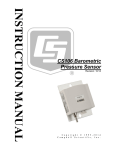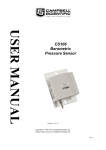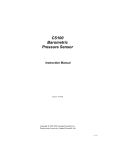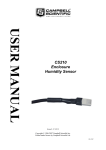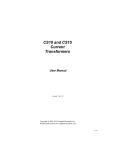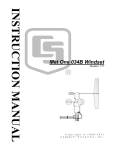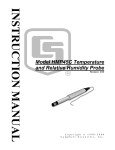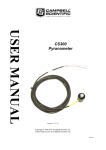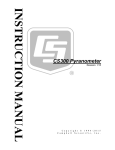Download Campbell CS106 Product manual
Transcript
CS106 Barometric Pressure Sensor Revision: 11/11 C o p y r i g h t © 1 9 9 5 - 2 0 1 1 C a m p b e l l S c i e n t i f i c , I n c . Warranty “PRODUCTS MANUFACTURED BY CAMPBELL SCIENTIFIC, INC. are warranted by Campbell Scientific, Inc. (“Campbell”) to be free from defects in materials and workmanship under normal use and service for twelve (12) months from date of shipment unless otherwise specified in the corresponding Campbell product manual. Batteries, fine-wire thermocouples, desiccant, and other consumables have no warranty. Campbell's obligation under this warranty is limited to repairing or replacing (at Campbell's option) defective products, which shall be the sole and exclusive remedy under this warranty. The customer shall assume all costs of removing, reinstalling, and shipping defective products to Campbell. Campbell will return such products by surface carrier prepaid within the continental United States of America. To all other locations, Campbell will return such products best way CIP (Port of Entry) INCOTERM® 2010, prepaid. This warranty shall not apply to any Campbell products which have been subjected to modification, misuse, neglect, improper service, accidents of nature, or shipping damage. This warranty is in lieu of all other warranties, expressed or implied. The warranty for installation services performed by Campbell such as programming to customer specifications, electrical connections to products manufactured by Campbell, and product specific training, is part of Campbell’s product warranty. CAMPBELL EXPRESSLY DISCLAIMS AND EXCLUDES ANY IMPLIED WARRANTIES OF MERCHANTABILITY OR FITNESS FOR A PARTICULAR PURPOSE. Campbell is not liable for any special, indirect, incidental, and/or consequential damages.” Assistance Products may not be returned without prior authorization. The following contact information is for US and international customers residing in countries served by Campbell Scientific, Inc. directly. Affiliate companies handle repairs for customers within their territories. Please visit www.campbellsci.com to determine which Campbell Scientific company serves your country. To obtain a Returned Materials Authorization (RMA), contact CAMPBELL SCIENTIFIC, INC., phone (435) 227-2342. After an applications engineer determines the nature of the problem, an RMA number will be issued. Please write this number clearly on the outside of the shipping container. Campbell Scientific's shipping address is: CAMPBELL SCIENTIFIC, INC. RMA#_____ 815 West 1800 North Logan, Utah 84321-1784 For all returns, the customer must fill out a "Statement of Product Cleanliness and Decontamination" form and comply with the requirements specified in it. The form is available from our web site at www.campbellsci.com/repair. A completed form must be either emailed to [email protected] or faxed to (435) 227-9579. Campbell Scientific is unable to process any returns until we receive this form. If the form is not received within three days of product receipt or is incomplete, the product will be returned to the customer at the customer's expense. Campbell Scientific reserves the right to refuse service on products that were exposed to contaminants that may cause health or safety concerns for our employees. CS106 Table of Contents PDF viewers: These page numbers refer to the printed version of this document. Use the PDF reader bookmarks tab for links to specific sections. 1. General .........................................................................1 2. Specifications ..............................................................1 3. Installation and Wiring ................................................2 3.1 3.2 3.3 3.4 Jumper Settings.........................................................................................2 Datalogger Connection .............................................................................3 5-pin Screw Terminal Plug Connector .....................................................5 Mounting in an Enclosure.........................................................................5 4. Programming ...............................................................7 4.1 Conversion Factors ...................................................................................7 4.2 Program Examples....................................................................................8 4.2.1 Example 1 – Sample Program for CR1000 (CRBasic) Datalogger......8 4.2.2 Example 2 – Sample Program for CR10X (Edlog) Datalogger ......8 4.3 Long Lead Lengths.................................................................................10 4.4 Output Resolution...................................................................................10 5. Correcting Pressure to Sea Level ............................10 6. Maintenance and Calibration....................................11 Figures 3-1. 3-2. 3-3. 3-4. CS106 Jumper Set to Shutdown Mode....................................................3 CS106 Wiring Diagram...........................................................................4 Connector Key Attached to 5-pin Screw Terminal Plug Connector .......5 ENC100 is a very small enclosure that can house one CS106 ................6 Tables 3-1. Signal and Ground Connectors for CS106 ..............................................4 4-1. Conversion Factors for Alternative Pressure Units .................................7 i CS106 Barometric Pressure Sensor 1. General The CS106 analog barometer uses Vaisala’s Barocap® silicon capacitive pressure sensor. The Barocap sensor has been designed for accurate and stable measurement of barometric pressure. The CS106 outputs a linear 0 to 2.5 VDC signal that corresponds to 500 to 1100 mb. It can be operated in a shutdown or normal mode. In the shutdown mode the datalogger switches 12 VDC power to the barometer during the measurement. The datalogger then powers down the barometer between measurements to conserve power. 2. Specifications Operating Range Pressure: Temperature: Humidity: 500 mb to 1100 mb -40°C to +60°C non-condensing Accuracy ±0.3 mb @ +20°C ±0.6 mb @ 0°C to +40°C ±1 mb @ -20°C to +45°C ±1.5 mb @ -40°C to +60°C Linearity*: ±0.25 mb @ 20°C Hysteresis*: ±0.03 mb @ 20°C Repeatability*: ±0.03 mb @ 20°C Calibration Uncertainty**: ±0.15 mb @ 20°C Long-Term Stability: ±0.1 mb per year Total Accuracy*** * Defined as ±2 standard deviation limits of end-point non-linearity, hysteresis error, or repeatability error ** Defined as ±2 standard deviation limits of inaccuracy of the working standard at 1000 mb in comparison to international standards (NIST) *** Defined as the root sum of the squares (RSS) of end-point non-linearity, hysteresis error, repeatability error and calibration uncertainty at room temperature General Dimensions: 9.7 cm x 6.8 cm x 2.8 cm (3.8” x 2.7” x 1.1”) Weight: 90 g (3.2 oz) Housing Material: ABS/PC blend Supply Voltage: 10 to 30 VDC 1 CS106 Barometric Pressure Sensor Supply Voltage Control: When enabled with an internal jumper, the CS106 is on continually. When disabled, the CS106 can be turned on/off with 5 VDC/0 VDC. Supply Voltage Sensitivity: negligible Current Consumption: <4 mA (active); <1 μA (quiescent) Output Voltage: 0 to 2.5 VDC Warm Up Time: 1 second Pressure Fitting: barbed fitting for 1/8” I.D. tubing Overpressure Limit: 2000 mb NOTE The black outer jacket of the cable is Santoprene® rubber. This compound was chosen for its resistance to temperature extremes, moisture, and UV degradation. However, this jacket will support combustion in air. It is rated as slow burning when tested according to U.L. 94 H.B. and will pass FMVSS302. Local fire codes may preclude its use inside buildings. 3. Installation and Wiring 3.1 Jumper Settings The CS106 can be operated in one of two modes: shutdown and normal. The mode is selected by a jumper located underneath the plastic cover of the barometer. When the jumper is not installed, the CS106 is in shutdown mode and the datalogger turns the CS106 on and off with a control port or excitation channel; to use the excitation channel the datalogger must be able to provide an excitation voltage of 5 VDC. When the jumper is installed the CS106 is in normal mode and powered continuously. NOTE CS106s shipped from Campbell Scientific are configured for shutdown mode (jumper open). The location of the jumper is shown in Figure 3-1. 2 CS106 Barometric Pressure Sensor Jumper FIGURE 3-1. CS106 Jumper Set to Shutdown Mode 3.2 Datalogger Connection Before connecting the barometer to the datalogger, a yellow warning label must be removed from the pigtails. The warning label reminds the user of the importance of properly connecting the barometer to the datalogger. Wiring is shown in Figure 3-2 and Table 3-1. 3 CS106 Barometric Pressure Sensor See Table 3-1 Blue – Pressure (VOUT) See Table 3-1 Yellow – Signal Ground (AGND) Continuous 12 VDC Red – 12 VDC (SUPPLY) See Table 3-1 Black – Power Ground (GND) Control Port or Excitation Channel Green – Control (EXT. TRIG) Ground or Analog Ground Clear – Shield (G or AGND) FIGURE 3-2. CS106 Wiring Diagram TABLE 3-1. Signal and Ground Connectors for CS106 Wire CS106 Terminal Datalogger Single-Ended Measurement Datalogger Differential Measurement Blue VOUT S.E. Input High Side of Diff Input Yellow AGND AG (CR10(X), CR500, CR510) (Other Dataloggers) Low Side of Diff. Input Black GND (21X, CR7, CR9000(X)) G (Other Dataloggers) (21X, CR7, CR9000(X)) G (Other Dataloggers) Green EXT TRIG Control port (use to turn power on/off) Control port (use to turn power on/off) Red SUPPLY 12 VDC 12 VDC Shield Shield G (CR10(X), CR500, CR510) (Other Dataloggers) G (CR10(X), CR500, CR510) (Other Dataloggers) 4 CS106 Barometric Pressure Sensor WARNING Improper wiring may damage the CS106 beyond repair. 3.3 5-pin Screw Terminal Plug Connector The datalogger connects to the CS106 via a 5-pin screw terminal plug connector. This connector is removable and may be replaced. The replacement connector may come with a connector key attached to it to ensure that the connector is plugged into the CS106 right side up (see Figure 3-3). When the connector is right side up, it will easily plug into the barometer. FIGURE 3-3. Connector Key Attached to 5-pin Screw Terminal Plug Connector WARNING A 5-pin screw terminal that is plugged in upside down will damage the sensor—perhaps beyond repair. 3.4 Mounting in an Enclosure To prevent condensation, install the sensor in an environmentally protected enclosure, complete with desiccant, which should be changed at regular intervals. CAUTION Failure to protect the sensor from condensation may result in permanent damage. The CS106 is typically mounted in a Campbell Scientific enclosure next to the datalogger. Campbell Scientific also offers the ENC100 for situations where it is desirable to house the CS106 in its own enclosure (see Figure 3-4). The ENC100 is a 6.7-in. x 5.5-in. x 3.7-in. enclosure that includes a compression fitting for cable entry, a vent for equalization with the atmosphere, a backplate for mounting the CS106, and hardware for mounting the ENC100 to a tripod, tower, or pole. 5 CS106 Barometric Pressure Sensor FIGURE 3-4. ENC100 is a very small enclosure that can house one CS106. Remember that for the sensor to detect the external ambient pressure, the enclosure must vent to the atmosphere (i.e., not be ‘hermetically sealed’). Enclosures purchased from Campbell Scientific properly vent to the atmosphere. NOTE For user-supplied enclosures, it may be necessary to make a vent hole on the outer wall. In this situation, do not make the hole on one of the vertical side walls, as wind blowing around it can cause transient changes in pressure. The mounting holes for the sensor are one-inch-centered (three inches apart), and will mount directly onto the holes on the backplate of Campbell Scientific enclosures. Mount the sensor with the pneumatic connector pointing vertically downwards to prevent condensation collecting in the pressure cavity, and also to ensure that water cannot enter the sensor. 6 CS106 Barometric Pressure Sensor 4. Programming The CS106 sensor is measured using the singled-ended voltage measurement instruction (VoltSe in CRBasic or P1 in Edlog). Atmospheric pressure changes little with time. In most weather station applications measuring pressure once an hour is adequate. Program Example 1 is for the dataloggers that use the CRBasic language, such as CR200(X), CR800, CR850, CR1000, CR3000, CR5000, and CR9000(X). In the example, the CR1000 measures the CS106 once an hour in a program that runs at 1 Hz. In order to keep the CR1000 running in a pipeline mode, the measurement instruction is placed outside the “If” statement. The measurement is made every scan, and the measured value is first written into a temporary variable called "CS106_temp". Once the CS106 is turned on one minute before the hour, the CS106 starts to make the correct pressure measurements. At the top of the hour, the correct value is copied into the current variable called "pressure", and the sensor is turned off immediately. In Program Example 1, the integration parameter for the VoltSe instruction is _60Hz. However, for Eddy Covariance programs or other datalogger programs that are executed at a higher frequency, the integration parameter should be 250 µsec instead of _60Hz or _50Hz. This prevents skipped scans. In Program Example 2, the CR10X datalogger (Edlog datalogger) turns on the CS106 one minute before the top of the hour using a control port. On the hour the datalogger measures the CS106, and then it turns the CS106 off. 4.1 Conversion Factors In the example programs, the pressure is reported in millibars (mb). To report pressure in different units, multiply the measured pressure by the appropriate conversion factor. This is done by including an expression in a CRBasic program or using Instruction 37 (P37) in an Edlog program. See Table 4-1 below for conversion factors. TABLE 4-1. Conversion Factors for Alternative Pressure Units To Find hPa kPa mm of Hg in of Hg Psi Atm Torr Multiply by 1.0 0.1 0.75006 0.02953 0.0145 0.00099 0.75006 7 CS106 Barometric Pressure Sensor 4.2 Program Examples 4.2.1 Example 1 – Sample Program for CR1000 (CRBasic) Datalogger 'CR1000 Datalogger Public CS106_temp, pressure Units pressure = mbar DataTable (met_data,True,-1) DataInterval (0,60,min,10) Sample (1,pressure,IEEE4) EndTable BeginProg PipeLineMode Scan (1,sec,3,0) 'Measurement is made every scan outside the "If" statement VoltSe (CS106_temp,1,mV2500,1,False,0,_60Hz,0.240,500) 'Turn on CS106 one minute before the hour If (IfTime (59,60,min)) Then WriteIO (&b1000,&b1000) 'Copy the correct value to a current variable called "pressure" at the top of the hour 'Turn off CS106 after the measurement If (IfTime (0,60,min)) Then pressure = CS106_temp WriteIO (&b1000,&b0) EndIf CallTable met_data NextScan EndProg 4.2.2 Example 2 – Sample Program for CR10X (Edlog) Datalogger ;{CR10X} *Table 1 Program 01: 1 Execution Interval (seconds) ;Turn on CS106 one minute before the hour ; 1: If time is (P92) 1: 59 Minutes (Seconds --) into a 2: 60 Interval (same units as above) 3: 41 Set Port 1 High 8 CS106 Barometric Pressure Sensor ;Measure CS106 at the top of the hour ; 2: If time is (P92) 1: 0 Minutes (Seconds --) into a 2: 60 Interval (same units as above) 3: 30 Then Do 3: Volt (SE) (P1) 1: 1 2: 25 3: 1 4: 1 5: 0.240 6: 500 ;Turn off CS106 ; 4: Do (P86) 1: 51 Reps 2500 mV 60 Hz Rejection Range SE Channel Loc [ CS106 ] Multiplier Offset Set Port 1 Low 5: End (P95) ;Store CS106 data once an hour ; 6: If time is (P92) 1: 0 Minutes (Seconds --) into a 2: 60 Interval (same units as above) 3: 10 Set Output Flag High (Flag 0) 7: Real Time (P77) 1: 0110 Day,Hour/Minute (midnight = 0000) ;Store in high resolution mode to retain 0.01mb resolution ; 8: Resolution (P78) 1: 1 High Resolution 9: Sample (P70) 1: 1 2: 1 Reps Loc [ CS106 ] *Table 2 Program 01: 0 Execution Interval (seconds) *Table 3 Subroutines End Program -Input Locations1 CS106 1 1 1 9 CS106 Barometric Pressure Sensor 4.3 Long Lead Lengths There is a 0.06 mV/foot voltage drop in the CS106 signal leads. This voltage drop, in long lead lengths, will raise the barometric reading by approximately 1.44 mb per 100 feet. For lead lengths greater than 20 feet, use the differential instruction (Instruction 2) to measure the CS106. 4.4 Output Resolution When storing the values from the CS106 to a datalogger’s final storage location, or to a data table, care must be taken to choose suitable scaling of the reading, or to store the value with adequate resolution to avoid losing useful resolution of the pressure measurement. The default resolution (low resolution) for Campbell Scientific dataloggers is limited to a maximum of four digits. Even then, the maximum digit value that can be displayed is 7999 for the CRBasic dataloggers and 6999 for Edlog dataloggers. If you use this option with barometric data scaled in millibars (hPa), a reading above 799.9 mb for CRBasic dataloggers (699.9 mb for Edlog dataloggers) will lose one digit of resolution (e.g. at 900 mb, the resolution is limited to 1 mb). To retain 0.01 mb resolution, you either need to subtract a fixed offset from the reading before it is stored to avoid exceeding the 799.9 for CRBasic dataloggers (699.9 for Edlog dataloggers) threshold, or output the barometric reading in high resolution format. This can be done by using the IEEE4 format for CRBasic dataloggers or the Resolution (P78) instruction in the Edlog dataloggers. The default data output format for CR200(X) series datalogger is IEEE4. 5. Correcting Pressure to Sea Level The weather service, most airports, radio stations, and television stations adjust the atmospheric pressure to a common reference (sea level). Equation 1 can be used to find the difference in pressure between the sea level and the site. That value (dP) is then added to the offset (500 mb in our example programs) in the measurement instruction. U. S. Standard Atmosphere and dry air were assumed when Equation 1 was derived (Wallace, J. M. and P. V. Hobbes, 1977: Atmospheric Science: An Introductory Survey, Academic Press, pp. 59-61). ⎪⎧ ⎛ ⎞5.25328 ⎪⎫ E ⎬ dP = 1013.25 ⎨1 − ⎜1 − ⎟ ⎭⎪ ⎩⎪ ⎝ 44307.69231⎠ (1) The value dP is in millibars and the site elevation, E, is in meters. Add dP value to the offset in the measurement instruction. Use Equation (2) to convert feet to meters. E(m) = 10 E( ft ) 3.281ft m (2) CS106 Barometric Pressure Sensor The corrections involved can be significant: e.g. at 1000 mb and 20°C, barometric pressure will decrease by 1.1 mb for every 10 meter increase in altitude. 6. Maintenance and Calibration Since the sensor is semi-sealed, minimum maintenance is required: 1. Visually inspect the cable connection to ensure it is clean and dry. 2. Visually inspect the casing for damage. 3. Ensure that the pneumatic connection and pipe are secure and undamaged. The external case can be cleaned with a damp, lint-free cloth and a mild detergent solution. Vaisala recommends recalibration every two years under normal use. In areas where a lot of contaminants are present, recalibration every year is recommended. Contact Campbell Scientific, Inc. (435-753-2342) for an RMA number before returning the sensor for recalibration. Should you lose the five terminal connector (p/n 16004), the replacement part can be purchased from Campbell Scientific, Inc. Contact Campbell Scientific, Inc. to purchase the part. CAUTION The CS106 is sensitive to static when the backplate is removed. To avoid damage, take adequate anti-static measures when handling. 11 CS106 Barometric Pressure Sensor 12 Campbell Scientific Companies Campbell Scientific, Inc. (CSI) 815 West 1800 North Logan, Utah 84321 UNITED STATES www.campbellsci.com • [email protected] Campbell Scientific Africa Pty. Ltd. (CSAf) PO Box 2450 Somerset West 7129 SOUTH AFRICA www.csafrica.co.za • [email protected] Campbell Scientific Australia Pty. Ltd. (CSA) PO Box 444 Thuringowa Central QLD 4812 AUSTRALIA www.campbellsci.com.au • [email protected] Campbell Scientific do Brazil Ltda. (CSB) Rua Luisa Crapsi Orsi, 15 Butantã CEP: 005543-000 São Paulo SP BRAZIL www.campbellsci.com.br • [email protected] Campbell Scientific Canada Corp. (CSC) 11564 - 149th Street NW Edmonton, Alberta T5M 1W7 CANADA www.campbellsci.ca • [email protected] Campbell Scientific Centro Caribe S.A. (CSCC) 300 N Cementerio, Edificio Breller Santo Domingo, Heredia 40305 COSTA RICA www.campbellsci.cc • [email protected] Campbell Scientific Ltd. (CSL) Campbell Park 80 Hathern Road Shepshed, Loughborough LE12 9GX UNITED KINGDOM www.campbellsci.co.uk • [email protected] Campbell Scientific Ltd. (France) 3 Avenue de la Division Leclerc 92160 ANTONY FRANCE www.campbellsci.fr • [email protected] Campbell Scientific Spain, S. L. Avda. Pompeu Fabra 7-9, local 1 08024 Barcelona SPAIN www.campbellsci.es • [email protected] Please visit www.campbellsci.com to obtain contact information for your local US or International representative.




















